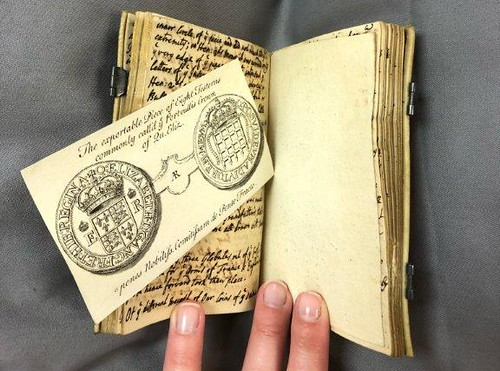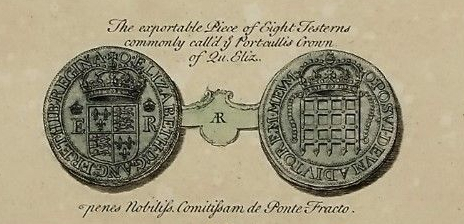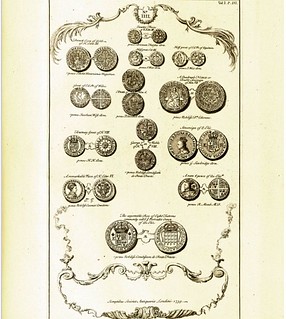
PREV ARTICLE
NEXT ARTICLE
FULL ISSUE
PREV FULL ISSUE
BOOK CUTTING ANSWER: VETUSTA MONUMENTAE-Sylum readers are simply amazing when it comes to knowing or knowing how to find numismatic information of all kinds. Among the most prolific of these are Julia Casey and Ron Haller-Williams, whom I earlier dubbed our "Googler-in-Chief". They both came through with a spot-on answer to David Pickup's question on the origin of this book cutting he found tipped into another book. Thanks!! -Editor  Ron was the first to report his discovery, and Julia was close on his heels. Their answer? The book cutting comes from Vetusta Monumenta, a seven-volume work on ancient buildings, sites, and artifacts published in Latin. -Editor    Left: Ron's Find; Right: Julia's Find. Click on links below for full images For Ron's reference, see: For Julia's references, see: They make this look easy. So how do they DO this magic, anyway? Bruce Bartelt had an inkling. -Editor Bruce Bartelt writes: I have some book cuttings that a friend in my local club gave me. Mine have text on the back and a simple Google Books search using a phrase from the text quickly turned up an exact match with The History of England, by Rapin de Throyas (translated by N. Tindel, 3rd Edition 1743). It also illustrates the portcullis coin that Mr. Pickup's cutting shows, but is a different engraving. So that would be an avenue to pursue should there be any text on the back of Mr. Pickup's cutting. Excellent idea! Web search is an amazing tool. That's what led Julia and Ron to nail down the culprit. Here's Ron's detailed account. -Editor Bob Van Arsdell seems to have been right when he ended up with "It’s possible the book may not have been a numismatic one", based on his earlier comment that "the coin was well-known by the 18th Century, so it didn’t warrant the elaborate title if was included in a plate of many coins in a numismatic work." However, he was wrong in guessing that it "could be an in-line plate in a page of text". In fact, it is a full-page plate, see https://i.ebayimg.com/images/g/KPUAAOSww85acENd/s-l1600.jpg It is/was plate lvi (56) of Volume I of "Vetusta Monumenta ..." (Society of Antiquaries of London, published 1747 though the plate is dated 1739) - and also in Volume 1 of Lord Oxford's collection (which I haven't yet tracked down, unless it's the sale catalogue). See https://en.wikipedia.org/wiki/Vetusta_Monumenta and https://en.wikipedia.org/wiki/Society_of_Antiquaries_of_London In "NOTES FROM E-SYLUM READERS: MARCH 26, 2017" you labelled me as "Googler-in-Chief" !!! Well, explorations like this can be very hard work - this is how I did it. I noticed that the caption starts with "the exportable piece of eight ...". 1: Google this, for BOOKS (WITH the quotes, which mean "exact phrase"): "the exportable piece of eight" 2: This gives one hit - investigate! It is referenced on page 358 of Volume 70 of the Walpole Society, (re)published/digitized 4 Nov 2008. 3. The reference-number "811" looks significant, so search the book for this number - it also appears on p.395. 4: Now Google this: "Walpole Society" Volume 70 5: The first hit is https://www.jstor.org/stable/i40086491 6: Go there (click on the heading of the "hit"): The Table of Contents shows: GEORGE VERTUE AS AN ENGRAVER (pp. 207-517) by David Alexander at https://www.jstor.org/stable/41830020 7: Go there (click on the link). 8: Click on the "Read Online (Free)" button. 9: If not already logged in, either log in or sign up (free to access up to 6 articles per month). 10: Use the "thumbnails" tab to navigate to p.358. 11: Take a good look at this reference and the preceding one (811 & 810). Observe that there is a reference to "Lord Oxford": This would be Edward Harley, 2nd Earl of Oxford and Earl Mortimer (1689-1741), see https://en.wikipedia.org/wiki/Edward_Harley,_2nd_Earl_of_Oxford_and_Earl_Mortimer not his son, the 3rd Earl, who immediately sold off the collections! [Do not confuse with the Earl of Orford, e.g. the 4th Earl, Horatio "Horace" Walpole (1717-1797).] 12. Note that the previous reference (810) mentions "a gold coin of mary queen of scots" so make a note of this. 13. See also p.394 & 395 - we see that (as expected) we want Plate 56 of Volume 1, originally issued at price one shilling and three pence (£0.0625 or $0.25). 14: See also the "References" tab, and scroll down to read the bits on "Vetusta Monumenta" and "Walpole, 1762". 15: Google the phrase from step 12, and get lucky! 16. Click on the first hit, to find somebody selling the plate on eBay for $39.99, item #173129496294 17. Note the date of the engraving (1739), and use this in step 19. 18. Click on "Visit store". 19. Search that eBay store for: COINS 1739 20. One of the four hits is what we want, so click on it: item #173129489368 "Coins Struck in France and Flanders Relating to England - QUARTER FLOREN -1739" 21: See also https://books.google.co.uk/books?id=ntc_AQAAMAAJ&pg=PA418 So: It is the lowest piece illustrated on a full-page plate is by George Vertue. These plates were available both loose (this one was £0.0625) AND bound or gathered into a volume (for some 11.4% more than the individual total). P.S. To find out more about this engraver, try https://en.wikipedia.org/wiki/George_Vertue He was official engraver to the Society of Antiquaries. Additionally he produced a numismatic work which deserves to be better known than it is: Medals, coins, great seals, and other works of Thomas Simon, engraved and described by George Vertue. Printed by J. Nichols, printer to the Society of Antiquaries. (1780 - 27 pages), see https://books.google.co.uk/books?id=yWAGAAAAQAAJ&printsec=frontcover#v=onepage&q&f=false Wow! Thanks for the detailed account, and all your hard work. This is a great example for other researchers. -Editor To read the earlier E-Sylum articles, see: Wayne Homren, Editor The Numismatic Bibliomania Society is a non-profit organization promoting numismatic literature. See our web site at coinbooks.org. To submit items for publication in The E-Sylum, write to the Editor at this address: whomren@gmail.com To subscribe go to: https://my.binhost.com/lists/listinfo/esylum All Rights Reserved. NBS Home Page Contact the NBS webmaster 
|